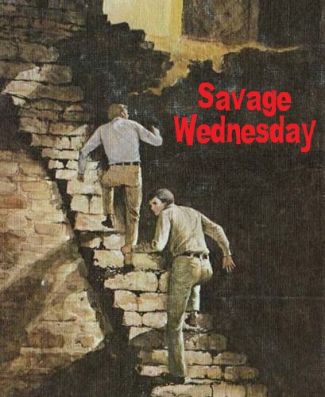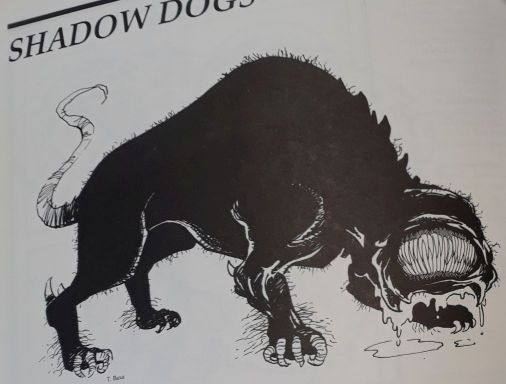Savage Wednesday: The Story Begins
This past Saturday, the link to the work-in-progress The Kids’ Game campaign using Savage Worlds Deluxe Explorer’s Edition began. Four players created four 13- to 14-year-old characters: John, the rich kid; Bin, the bookworm; Ganke, the honor student; and Mario, the troubled teen. All four kids reside in a Miami suburb in the 1980s. They’re not necessarily friends, but they still managed to get into trouble together after loose talk moved into dares about breaking into Old Man Sutherland’s house at the end of a street in a well-heeled neighborhood. The kids were caught, and Mario’s police officer dad organized the punishment: clean Sutherland’s vast attic over the course of a Saturday afternoon.

Sutherland, wheelchair-bound and aged, lives alone, but every room of his spacious home is wired for intercom. Hidden cameras monitor the interior and exterior. Kids being kids, half the group went to work while the other half didn’t. Mario moved an over-stuffed box. The bottom fell out, dumping its contents, which included a handsome, leather-bound manuscript.
Within the covers? A handwritten description of something called a “role-playing game” titled “Savage Worlds”. A true oddity, for in the kids’ world, no such thing as a role-playing game exists. There is no TSR or Mayfair Games. Gary Gygax publishes mediocre fantasy fiction, not culture-changing games. During lunch, Old Man Sutherland explained the game, and offered to show the kids how to play.
“Better than attic cleaning,” he said.
And so the kids made up fantasy characters, guardians in a magical world called Aysle. John made up Dark Halo, magical bounty hunter. Bin created Books, a golem. (“Android!” Bin insists.) Ganke’s character is Lander Foxglove, cat-man warrior, and Mario made up Haldir, elven archer. Sutherland explained that their characters were on the road through the woods, returning to a keep in a frontier region.
With a pop!, the lights in Sutherland’s house went out. Floodlights glared through the front windows, and a voice boomed, “Come out slowly! Bring the Book and the Dice!”
Old Man Sutherland thrust the book into Mario’s hands and the dice into John’s grip. “Run!” he said. “Protect the Book and the Dice!”
And so the kids ran out the back door and across the lawn, pursued by men in bulletproof vests and ski masks. Men armed with firearms they proved willing to use, but — thank goodness! — the weapon aimed at Mario jammed when the trigger was pulled. The kids scattered and hid.
And then all the lights went vanished. The buildings vanished. Miami disappeared. One second, it was there. The next: nothing but forest and hills. John, Bin, Ganke, and Mario were changed. They’d become their characters in a frontier region of Aysle….
The World Rules
The magical realm of Aysle is borrowed from Torg by West End Games. Aysle differs greatly from Miami in the 1980s. Specifically, there are four immutable Laws that govern life in Aysle.
The Law of Observation
What can be observed through the senses is real. Every real thing is the result of a previous observation. That which cannot be sensed is not real. This does not, however, mean that every individual creature lives its own reality. Solipsism is not possible in Aysle. That castle is real because it has been observed. Maybe not by you, but by others. In Aysle, observation creates theories, rather than the other way around, where theories require testing by observation. What is or has been observed is true.
The Law of Magic
Magic has been observed; therefore, magic is real. Every sentient being in Aysle has at least the potential to use magic. Most beings do not invest the time and effort into honing their preternatural senses. Nevertheless, magic is common in Asyle. One might meet a humble farmer whose soothing words repel vermin from his fields. The interaction between the Law of Observation and the Law of Magic has consequences for illusions. An illusion, once perceived, might become real, at least for a time. An illusion that becomes real might behave as appropriate for whatever it is. Illusionists take note: That image of a chimera might scare off those guards, but it might also become a chimera, at which time it’s no longer under your control.
The Laws of Honor and Corruption
The Law of Honor declares that good deeds cannot be hidden. The honorable creature embodies honor, which is reflected outwardly in appearance and bearing. Likewise, the Law of Corruption declares that evil deeds cannot be hidden, but is reflected outwardly as well. Most denizens of Aysle do not exhibit exceptional honor or corruption. They seldom perform heroic deeds. They seldom perform evil deeds. Their lives includes many minor decisions for good or against good, and the net effect is negligible. Some creatures, however, dedicate their lives to honor or corruption.
For the heroes in Aysle, this means that their actions will see an accumulation of Honor Points and Corruption Points based on the actions the hero performs during the course of an adventure. Think of Honor Points as positive numbers and Corruption Points as negative numbers. At the end of an adventure, if the total is positive, the hero gains Honor. If the total is negative, the hero gains Corruption. These points are tracked like XP. For every 5 Honor Points, the hero gains a step up on his Honor skill (starting with 1d4, then 1d6, et cetera). For every 5 Corruption Points, the hero gains a step up on his Corruption skill. Unlike other skills, Honor and Corruption do not increase based on XP, but only due to Honor Points and Corruption Points. Honor and Corruption skills can also decrease or even be lost (no die assigned). Honor and Corruption cannot be used unskilled.
Nota Bene: The specific effects of Honor and Corruption are beyond the scope of this post. I’ll be typing them up as part of the The Kids’ Game document or as part of a separate document about Aysle. When it’s ready, I’ll post the link.


